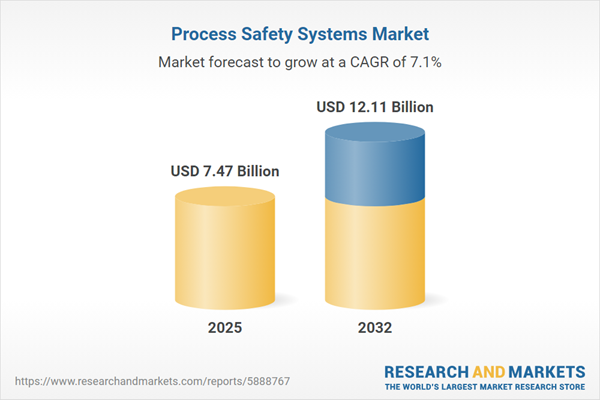Speak directly to the analyst to clarify any post sales queries you may have.
The process safety systems market is experiencing rapid transformation as organizations respond to changing regulations, evolving operational risks, and the accelerated adoption of digital safety solutions. Senior decision-makers are navigating new compliance demands while optimizing enterprise resilience and workforce safety.
Market Snapshot: Process Safety Systems Market Size and Growth Forecast
The global process safety systems market is projected to reach USD 6.98 billion in 2024, rising to USD 7.47 billion by 2025 and advancing further to USD 12.11 billion by 2032. This sustained growth, with a 7.12% CAGR, is powered by increasing investments in compliance-centric infrastructure, digital transformation initiatives, and advanced risk management strategies. Senior executives recognize process safety systems as an essential enabler of not just regulatory compliance but also greater operational continuity and competitive positioning across sectors.
Scope & Segmentation
- End User Industry: Chemicals, oil and gas, pharmaceuticals, food and beverage, and power generation companies each confront distinct process safety challenges. For example, energy firms give priority to explosion mitigation, while pharmaceutical operations rely on contamination controls to uphold product quality and meet strict industry standards.
- Component Type: Hardware solutions include emergency shutdown systems, safety instrumented components, and detection units tailored for real-time monitoring. Service offerings comprise specialized consulting, engineering, commissioning, maintenance, and operator training, ensuring optimal installation and lifecycle performance. Software platforms focus on supervisory control, analytics, diagnostics, and simulation to drive process insight and reinforce safety event response.
- Deployment Mode: Organizations implement on-premise and cloud-based models, incorporating public, private, and hybrid environments. This flexibility allows alignment with current IT infrastructure and regulatory mandates, improving scalability and readiness for digital integration.
- Application: Solutions are tailored for batch-processing industries such as specialty chemicals and pharmaceuticals, requiring adaptable and flexible frameworks. Continuous processing sectors, such as refining, benefit from advanced automation and real-time responses. The rise of hybrid processing approaches supports efficient operations along complex, multi-stage production lines.
- Regions: Adoption spans the Americas, Europe, Middle East and Africa, and Asia-Pacific. Within Asia-Pacific, countries including China, India, Japan, South Korea, Australia, Southeast Asia, and Taiwan display variations based on their regulatory maturity, infrastructure, and workforce expertise. Each region approaches compliance and risk management to best fit industrial conditions and local statutory standards.
Key Takeaways for Senior Decision-Makers
- Driving digital transformation enhances real-time identification of operational risks and supports a proactive safety culture embedded throughout the organization.
- Strategic alignment of process safety systems with environmental, social, and governance (ESG) objectives helps organizations advance sustainability initiatives and maintain stakeholder trust.
- Integrating cybersecurity measures directly into safety architectures addresses potential vulnerabilities at the intersection of OT, IT, and risk management.
- Flexible, modular system architectures help organizations adapt quickly to policy updates, ensuring agility across production and business processes.
- Bolstering the diversity of suppliers and maintaining transparent procurement processes contributes to building more resilient supply chains, capable of adjusting to sourcing and regulatory fluctuations.
- Continuous operator development and cross-disciplinary training are critical to maintaining peak safety system reliability and driving process improvement enterprise-wide.
Tariff Impact on Supply Chains and Procurement
Recent shifts in U.S. tariffs have prompted organizations to revise global sourcing and procurement strategies, increasing reliance on local partnerships and adjusting supply cycle timelines. These changes contribute to broader adoption of modular solutions, facilitating faster responses to evolving regulations and variable trade conditions. Proactive compliance monitoring is an emerging focus, allowing organizations to minimize operational disruption while remaining responsive to uncertain economic and regulatory environments.
Methodology & Data Sources
This report is informed by direct interviews with executive leaders and technical experts, providing insight into current adoption trends and market drivers. Rigorous validation is achieved through the review of regulatory documents, patent literature, and authoritative technology publications, with subject matter experts ensuring accuracy throughout the analysis.
Why This Report Matters
- Empowers decision-makers with actionable insight into process safety system trends, supporting strategic planning and agile risk response in complex regulatory contexts.
- Equips teams with clear benchmarks for procurement and operational safety practices, reinforcing consistent alignment with sector compliance requirements.
- Facilitates deployment of sustainable safety initiatives, enhancing organizational readiness for future changes in market or regulatory landscapes.
Conclusion
Advanced process safety systems are foundational to enterprise resilience, delivering robust compliance and performance in critical industries. Integrating technology, skilled personnel, and effective practices enables organizations to drive sustainable success and manage risk proactively.
Additional Product Information:
- Purchase of this report includes 1 year online access with quarterly updates.
- This report can be updated on request. Please contact our Customer Experience team using the Ask a Question widget on our website.
Table of Contents
3. Executive Summary
4. Market Overview
7. Cumulative Impact of Artificial Intelligence 2025
Companies Mentioned
The companies profiled in this Process Safety Systems market report include:- Emerson Electric Co.
- Honeywell International Inc.
- ABB Ltd.
- Schneider Electric SE
- Siemens Aktiengesellschaft
- Yokogawa Electric Corporation
- Rockwell Automation, Inc.
- Mitsubishi Electric Corporation
- General Electric Company
- Azbil Corporation
Table Information
| Report Attribute | Details |
|---|---|
| No. of Pages | 194 |
| Published | November 2025 |
| Forecast Period | 2025 - 2032 |
| Estimated Market Value ( USD | $ 7.47 Billion |
| Forecasted Market Value ( USD | $ 12.11 Billion |
| Compound Annual Growth Rate | 7.1% |
| Regions Covered | Global |
| No. of Companies Mentioned | 11 |









